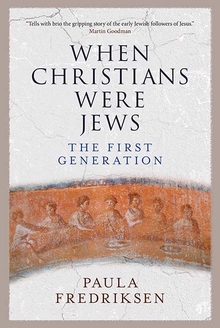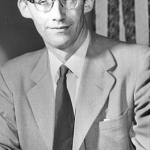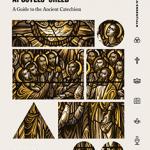When Christians Were Jews: The First Generation
New Haven, CN: Yale University Press, 2018.
Available at YUP.
I’ve been wanting to read this book ever since I missed out on picking up this book at SBL 2018 because of a certain unnamed Wipf & Stock editor, who used his privilege on being already within the book exhibits before opening, to go and purchase the last copy on the last day seconds before I got to it! I’ve forgiven him and we’ve been reconciled, but the loss still pains me. Nonetheless, the wait was worth it.
Paula Fredriksen (Hebrew University of Jerusalem) has written an eminently readable, informative, and engaging book about the early decades of the Christian movement. There’s many good points made, good descriptions of Josephus, Fredriksen points out that Jesus and his disciples were probably not carrying swords but sacrificial knives used to slaughter lambs, and lestes means “brigand” not “thief” (amen). It also rehearses many of Fredriksen’s arguments from her previous works, like Jesus did not claim to be the Messiah, but the crowds thought he was. Paul was an inside Judaism type of Apostle to the Gentiles. (In fact, the latter half of the book is one of the best summaries of the Paul within Judaism school you can find). In sum, Fredriksen describes the volume like this: “This book has tried to peer behind Acts, to understand what would have preceded the tales that shape Acts’ smooth narrative. … I have attempted to reimagine the stages by which the early Jesus-community would have first come together again, after the crucifixion. To understand how and why, despite the difficulties, these first followers of Jesus would have resettled in Jerusalem. To reconstruct the steps by which they became in some sense the center of a movement that was already fracturing bitterly within the two decades of its founder’s death, and fresh interpretation would have sustained this astonishing assembly in the long decades framed by Pilate’s troops in 20 and Titus’s in 70″ (184).
The book focuses particularly closely on this issue (from the blurb): How did a group of charismatic, apocalyptic Jewish missionaries, working to prepare their world for the impending realization of God’s promises to Israel, end up inaugurating a movement that would grow into the gentile church? Committed to Jesus’s prophecy—“The Kingdom of God is at hand!”—they were, in their own eyes, history’s last generation. But in history’s eyes, they became the first Christians.
For Fredriksen, the delay of the parousia, or a failed and then reinterpreted eschatology, is really the key to so much driving of early Christian thought and social experiment. She writes:
“For them, the resurrection validated and vindicated both Jesus’ message of the coming Kingdom together with his timetable: The Kingdom truly was at hand. Jesus’ own resurrection was for them meaningful as the first of a cascade of anticipated Endtime events. It signified and signified just how close the general resurrection of all the dead – and, thus, the establishment of God’s Kingdom – truly was” (86-87). Luke, says Fredriksen, writing in the early second century, “consistently tamps down and reshapes the vibrant apocalyptic tradition that originally shaped what he had inherited. His Jesus, in stake contrast to Mark’s, teaches against the idea of an impending kingdom … [parable of the talents in Luke 19]. No need to wait for the Endtime, teaches Luke’s Jesus: the Kingdom is already arrived, available as a present reality (93). Also: “Luke’s clam narrative smooths out these lived peaks of livid expectation, the valleys of disorienting cognitive dissonance, and the various solutions offered by creative reaffirmations. Luke betrays little of these processes. He speaks, instead, of the founding of the Christian church (184).
According to Fredriksen, factors which caused hope for the Kingdom to recede were the following (99-107): (1) A decrease in the number of persons experiencing posthumous appearances of the risen Jesus compensated for by an experience of charismatic empowerment; (2) An intensified turn to the Jewish scriptures to find new meanings to its past and present experiences; (3) a redefinition of the role of Messiah and the mode of being Messiah for Jesus; and (4) The church as continuing Jesus’ mission to prepare Israel for the kingdom. In her estimation: “The novel messianic idea was that the messiah had to come not once, but twice. The novel social idea was that the community, even absent Jesus, should continue his proclamation. In other words, this group’s evolving interpretation of Jesus as the Endtime messiah eventually propelled them to mount missions” (101). The acute irony is that the generation who thought they would be history’s last generation turned out to be the first generation of a movement that succeeded even as its main prophecy failed (133). All of Christian thought, at least in the early years, was a matter of cognitive dissonance and grappling with the failure of the Kingdom to materialize.
That is not a new idea. Albert Schweizer once said:
The whole history of ‘Christianity’ down to the present day, that is to say, the real inner history of it, is based on the ‘delay of the parousia’, i.e. the failure of the parousia to materialize, the abandonment of eschatology, and the progress and completion of the ‘de-eschatologizing’ of religion (Quest, 328).
In the mid-twentieth century, the so-called delay of the parousia was regarded as a kind of controlling matrix for the early church influencing scholars from Rudolf Bultmann to C.K. Barrett in their mapping of Christian origins. It has been especially important for studies of Luke-Acts because, so it goes, you don’t write the history of the church if you are expecting the world to end tomorrow, and this supposedly explains why Luke focuses on delay in many of his parables, he emphasizes a realized eschatology, he periodizes history into the time of Law/prophets-Jesus-“times of the gentiles”-then the parousia, and treats Spirit and mission as a substitute for consummation. (see e.g. Hans Conzelmann who based his entire Lukan theology around this).
However, I’d argue the whole delay of the parousia as the and driving factor of the early church is over-played.
First, the problem of delay was an inherent feature in Israel’s religion and second temple Judaism. You only have to read how Jeremiah’s 70 years of exile was turned into 490 years of exile by Daniel to see how prophecy could be reinterpreted in light of new struggles and challenges arising. Similarly, the entire book of Habbakuk deals the problem of the apparent delay in God’s salvation, which is taken up in places like the 1QpHab where the Qumranites deal with their own expectations and a supposed interim phase ahead of an apocalyptic denouement. A cursory search of the words, “How long Oh Lord” shows just how replete the problem of delay is across the Hebrew Bible. Thus, Christian reinterpretation of biblical texts around a two-stage advent of the messiah and asking “how long oh Lord how long” was not an innovation, but simply a deployment of Jewish resources to a recurrent problem of delay, albeit, played in new coordinates of a messianic eschatology.
Second, I’d argue that although Jesus was an apocalyptic prophet, he never said that a meltdown of history was just around the corner. Jesus focused much of his forecast – as did prophets before him (Jeremiah) and after him (Jesus ben Ananias)- on God’s judgment about the temple. I see very little reason to think Jesus spoke of events beyond the temple’s destruction in 70 AD other than a few tacit references about being with his disciples in the future state. If the Teacher of Righteousness, John the Baptist, Judas the Galilean, and Pharisaic leaders like Gamaliel, each with their own eschatological vision of the future, launched diverse Judean movements that survived well beyond them, there’s no reason to think that Jesus of Nazareth would have been any different.
Yes, Jesus can speak of the imminence of the kingdom (e.g. Mark 1:15), but the imminence of the kingdom must be understood in conjunction with other sayings and stories in which Jesus describes precursors to the kingdom’s advent. The trial or testing (peirasmos) has not yet occurred (Luke 11:4/Matt 6:13), persecution implies a further period of activity (Mark 8:35-38/Matt 16:25-27/Luke 9:24-26; Matt 10:16-25; Luke 11:49-50), Jesus’ refusal to drink from the “fruit of the vine” until the kingdom comes in its fullness (Mark 14:25/Matt 26:29/Luke 22:18), and his apparent ignorance of the timing of the end (Mark 13:32/Matt 24:36), may also be indicative of an interval of some kind. Similarly, the parables of growth (Mark 4:1-32/Matt 13:1-32/Luke 13:18-19/Gos Thom 9, 20), and the reference to time being cut short (Mark 13:20/Matt 24:22) show the same thing. The paradox between Jesus’ proclamation of both the imminence and presence of the kingdom is resolved when it is realized that Jewish thinking could accommodate the arrival of the kingdom as extending over time, in and through a series of events that could invade the present (e.g. Jubilees 23; 1 Enoch 91:12-17). What is more, some of these purportedly imminent sayings can arguably be identified with events other than a “cosmic meltdown” including Jesus’ death (Mark 9:1), the destruction of Jerusalem (Matt 10:23; Mark 13:30), or the enthronement of Jesus into heaven (Mark 14:62). Consequently, the reference to the kingdom’s imminence does not necessarily entail the imminence of the entire eschatological scenario.
Third, I’d argue that Luke doesn’t mute eschatological enthusiasm as much as modulate it. The parable of the unjust judge is about perseverance which does not require an imminent parousia (Luke 18:7). The parable of ten talents, in which the nobleman goes to a distant country to become king, is based on the problem of the kingdom’s imminence not its failure to materialize (Luke 19:11-27). It is the character of the wicked nobleman as a cipher for God rather than the issue of timing that is so striking in the parable (see Luke 19:27!). Spirit and openness to Gentiles is no more a substitute for a failed parousia than it is for Isaiah 2, 42, 49, 61, Joel 2, Zechariah 8, and Micah 4 which also look ahead to the giving of the Spirit and eschatological pilgrimage of the Gentiles as part of a prophetic restoration eschatology. In addition, I’ve always been fascinated by how Luke can simultaneously be concerned about Jewish rejection of Jesus (e.g. Acts 13:46; 18:6; 28:25-28), yet at the same time Luke keeps looking forward to Israel’s redemption and restoration (Luke 2:32; 24:21; Acts 1:6; Acts 3:20). In my mind, that is the real tension that Luke is trying to resolve!
For a summary of recent scholarship on Luke’s eschatology see Michael Fuller, The Restoration of Israel, p. 201, n. 18.
Fourth, the sense of anticipation in Christ’s parousia has always been qualified.
On the one hand, Fredriksen is right: “Belief that the world is imminently to end has been, paradoxically, one of the longest-lived convictions of Christian culture” (132). But on the other hand, this has never been without qualification or condition.
For case in point, Paul gives the impression of imminence to the parousia at the beginning (1 Thess 1:10; 4:15-17; 5:2; Phil 4:5) and end of his apostolic ministry (Rom 13:11; 16:20). But on the other hand, Paul also is aware that he and others could be dead when it happens (1 Cor 6:14: Phil 1:20-25; 2 Cor 5:1-10; Rom 14:8). In 1 Thessalonians Paul deals with the problem of a lack of eschatological interest but in 2 Thessalonians he deals with too much eschatological focus on Christ’s return.
If you look at early Jewish Christian tradition of the Maranatha prayer (1 Cor 16:22) and the epilogue to John’s Apocalypse, imminent apocalyptic hopes for Christ’s return seem rather stable (Rev 22:7, 12, 20). But then again, one senses the idea that the consummation of the kingdom requires perseverance and a struggle in both early tradition (e.g. “It is through many persecutions that we must enter the kingdom of God” [Act 14:22]) and even in the Apocalypse the issue of delay and perseverance is rehearsed (Rev 2-3; 6:10).
Victoria Balabanski (1997) has pointed out that if the early church was disappointed by the failure of Christ to return, such a disappointment is not reflected in the key texts. The intensity of hope for Christ’s return fluctuated in some contexts and there was no definite tendency towards diminished eschatological enthusiasm since Matthew actually intensifies rather than plays down Mark’s eschatological material.
I find it ironic that 2 Peter (possibly as late as the late second century) can offer an apology for the parousia in the face of scoffers who deny it is ever gonna happen by making an appeal to divine patience and God’s relative relationship to time and simultaneously see Christ coming like a thief in the night (2 Pet 3:4-10) even while Hippolytus in Rome around the same time could write the first Left-Behind novel called Christ and Anti-Christ and excite hopes for Christ’s return with little qualification at all, no diminished sense of Christ’s failed parousia even the late second or early third century. My point is that it is not all, “He’s coming, he’s coming … Oh, maybe not, well, um, how about a Gentile mission then, oh, and have some Holy Spirit as compensation!” Christian thought in the first two centuries at least shows a consistent pattern of expectation and contingency in explaining Christ’s parousia in its relationship to the church.
So while Fredriksen’s book is a fine read, ably addressing some of the big issues in Christian origins, filled with sober judgments and great insights, I think she has overcooked the delay of the parousia theme as the thing driving the whole Christian origins bus.
Coda: I think revisiting this topic would be a great task for a budding PhD student!
Further Reading:
Balabanski, Victoria. Eschatology in the Making: Mark, Matthew and the Didache. SNTS 97; Cambridge: CUP, 1997.
Bauckham, Richard. ‘The Delay of the Parousia.’ TynBul 31 (1980): 3-36.
Bird, Michael F. “Parousia,” in Encyclopedia of the Historical Jesus, ed. Craig A. Evans. New York: Routledge, 2008.
Conzelmann, Hans. The Theology of Saint Luke. London: Faber & Faber, 1960 (esp. 117-19).
Ellis, E. Earle. Christ and the Future in New Testament. Leiden: Brill, 2000.
Fuller, Michael E. The Restoration of Israel: Israel’s re-gathering and the fate of the nations in early Jewish literature and Luke-Acts (Berlin: de Gruyter, 2006).
Hays, Christopher M. (ed.). When The Son of Man Didn’t Come: A Constructive Proposal on the Delay of the Parousia. Minneapolis: Augsburg/Fortess, 2017.
Witherington, Ben. Jesus the Seer: The Progress of Prophecy. Minneapolis: Fortress, 2014 (esp. 263-65).
Wright, N.T. The New Testament and the People of God. COQG 1; London: SPCK, 1992 (esp. 342-43, 459-64).
Schweitzer, Albert. The Quest of the Historical Jesus. 6th edn; London: SCM, 2000.
Early Christianity 9 (2018): the whole issue is dedicated to it with articles by James C. Pagent, Tim Laato, and Christof Landmesser. You can read N.T. Wright’s piece “Hope Deferred? Against the Dogma of Delay“













